Colonoscopy
Colonoscopy is used to visually examine your entire colon and rectum for abnormalities. Colonoscopy is generally considered the procedure of choice for colon cancer screening and evaluation of rectal bleed, rectal mass, abdominal pain, unexplained constipation and other symptoms. During the exam, a colonoscope — a long, flexible tube about the thickness of an adult finger — is inserted into your rectum. A tiny video camera at its tip allows your doctor to view the inside of your colon.
In some cases during colonoscopy, if a polyp or abnormal tissue is found, your doctor may remove it at that time. Alternatively, a tissue sample (biopsy) of the polyp may be taken for lab analysis to determine whether subsequent surgical removal of the tissue is needed. Contact us for more information about colonoscopy in Beverly Hills

How do you prepare?
For the colonoscopy procedure to be accurate, your colon must be well prepared. It must be clear of stool and fluids that obscure the view of the colon and rectal lining.
What you do the day before the exam directly affects how well your colon can be examined. To prepare your colon, you’ll likely be asked to do the following during the 24 hours before the exam:
Stop taking iron pills or medications containing iron five days prior to the procedure. Iron can alter the color of your colon lining.
Take laxatives and sometimes enemas prescribed by your doctor.
Avoid eating solid foods and opaque liquids the day prior to the procedure.
The day prior to the procedure, drink only clear, nonalcoholic liquids such as black coffee, tea, water, or clear broth and juices without pulp. Eat only soft foods such as Jell-O — but not red Jell-O.
Avoid liquids that are red in color, as they can look red in the colon and be confused with blood.
Take a five-minute walk every 10 minutes during the time you’re drinking the laxative, but stay near a toilet.
During this preparation time, you may have a frequent and urgent need to use the toilet, due to the laxatives.
On exam day you will be asked to fast. In some cases your diet is again restricted to clear, nonalcoholic liquids for eight hours before the exam. At this point you stop ingesting anything, including any medications, until after the procedure.
If you have diabetes or take blood thinners, including aspirin or other pain relievers, your preparation for colonoscopy may be slightly different. Remind your doctor of either of these factors at least seven days ahead of the test, to see if you need additional instructions.
How is it done?
A colonoscopy is relatively painless when performed by an experienced practitioner. You will receive a sedative medication administered intravenously to minimize any discomfort.
During the exam you’ll likely lie on your left side. Dr. Davidson inserts the colonoscope into your rectum. Colonoscopes are disinfected between procedures, so the risk of transmission of infection is extremely low. The colonoscope is long enough to allow your doctor to view the entire length of your colon. It contains a fiber-optic light and a channel that allows your doctor to pump air into your colon, inflating it to get a better view of the interior lining. You may feel some abdominal cramping or pressure as the air is introduced.
The colonoscope also contains a tiny video camera at its tip. The camera transmits images to an external monitor so that your doctor can look closely at the inside of your colon. Your doctor can insert instruments through the colonoscope’s channel to remove polyps, take tissue samples, inject solutions or destroy (cauterize) tissues.
If a polyp or abnormal tissue is found, Dr. Davidson may choose to remove it with a snare or destroy it with cautery. Or he or she might take a biopsy or advise surgical removal, depending on the size of the mass.
A colonoscopy exam usually takes about 20 minutes to an hour.

After the procedure
After the exam is over, it takes less than an hour to recover from the sedative. You’ll need someone to take you home because it can take up to a day for the full effects of the sedative to wear off. Rest and don’t drive and do not sign any legal documents for the remainder of the day.
You may feel bloated or pass gas for a few hours after the exam. You should feel better as you pass the gas. Walking may lessen your discomfort. If you have persistent pain after the procedure, tell your doctor.
Results
Frequency of follow-up exams depends on the findings as well as the quality of the exam performed and should be discussed with your doctor. If a polyp or abnormal tissue was found during your colonoscopy that couldn’t be removed, Dr. Davidson may recommend subsequent procedures.

Negative test results. If no abnormalities are found, you can probably wait several years before repeating the exam, depending on your doctor’s recommendations.

Positive test results. If the colonoscopy reveals adenomatous polyps, you may have to adhere to a more rigorous screening schedule in the future, depending on the size and number of polyps.
Consider asking Dr. Davidson if it was a good-quality exam. If your colon wasn’t completely empty of stool at the time of the exam, parts of the colon may have been obscured. If so, abnormalities may not have been seen. Your doctor may even recommend that you have another colonoscopy in a year’s time or even sooner.
For more information about colonoscopy in Beverly Hills, contact Beverly Hills Physicians today. We have many offices in Los Angeles.
